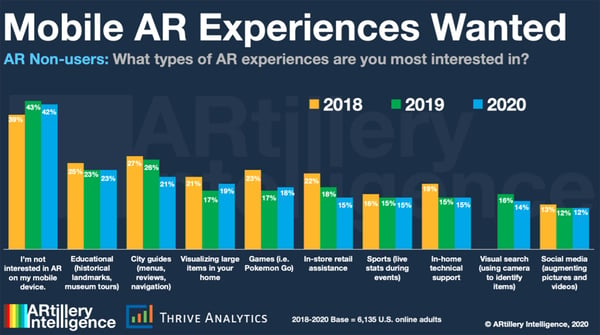Immersive technologies offer great power-ups for businesses to transform their brand storytelling into valuable online content people love to consume. In a world full of noise, immersive and interactive experiences are the number one tool for differentiation.
You might be wondering how to get started with extended reality and how to create value. If so, this is the article just for you. Here are our four tips to succeed with your XR content.
Define your concept and goals
In ARtillery Intelligence’s study on XR usage, the results show that immersive tech users expect it to have a practical approach. Applications such as education, history, and item visualization are among the most popular use cases.
Whether you want to approach your audience with these most-wanted XR applications or something entirely different, step into your audience’s shoes.
What kind of experience would be most beneficial to them?
What would bring them joy?
The value can arise both from utility and delight. And with XR, they often come together. What your audience doesn’t want is to waste their time.
Begin with crystallizing your concept. What are you trying to achieve, and what would delight your customers?
Extend your story
After having a clear concept in mind, the next thing is storytelling. With XR, you can tell a story that is engaging and immersive. When you offer your audience a chance to interact with great stories and experiences, you create value that’s close to impossible with other storytelling forms. You enable your audience to be a part of your story.
The key to immersive storytelling is interaction. Extended reality can offer an emotional impact; use it to your advantage.
Materials
To transform your message into an extended reality story, you need virtual objects. They can be photos, videos, 3D models or sounds, motion graphics, captured data, and so forth. In fact, you can display almost any digital content you already have at your disposal in XR. But of course, the best results come from materials specially designed for your immersive experience.
Then decide where and how your XR content will appear. Does it need a trigger image to appear, and will it attach itself to a print or a product? Is your XR experience based on a location, or can it be launched without any context?
The first step in putting your XR story together is creating your digital materials.
Choose your delivery
You can publish your XR to be app-based or experienced through a browser (WebXR or browser-based extended reality). Depending on the delivery method you choose, the quality and accessibility can vary. With in-app XR, you get more high-quality content, and you can utilize all of the cool sensors current mobile phones offer.
Still, the audience might feel uncomfortable having to download an app. WebXR is more accessible than an app and works magnificently, for example, in street ad campaigns. The downside is that the XR content needs to be more straightforward. Complex and high-quality content requires a lot of computing power, and XR running through a browser cannot offer the same experience as an app can.
Choose between app-based or browser-based XR, depending on your goals.
Succeed with XR
With many ways to go and many things to consider, XR offers almost endless possibilities. Whatever your goals, XR can be your medium for engaging and delighting your customers with an experience they remember.
If you’re in doubt about how to begin, get in touch with our XR experts.
You can also explore more about immersive technologies to find out what would match your goals.



